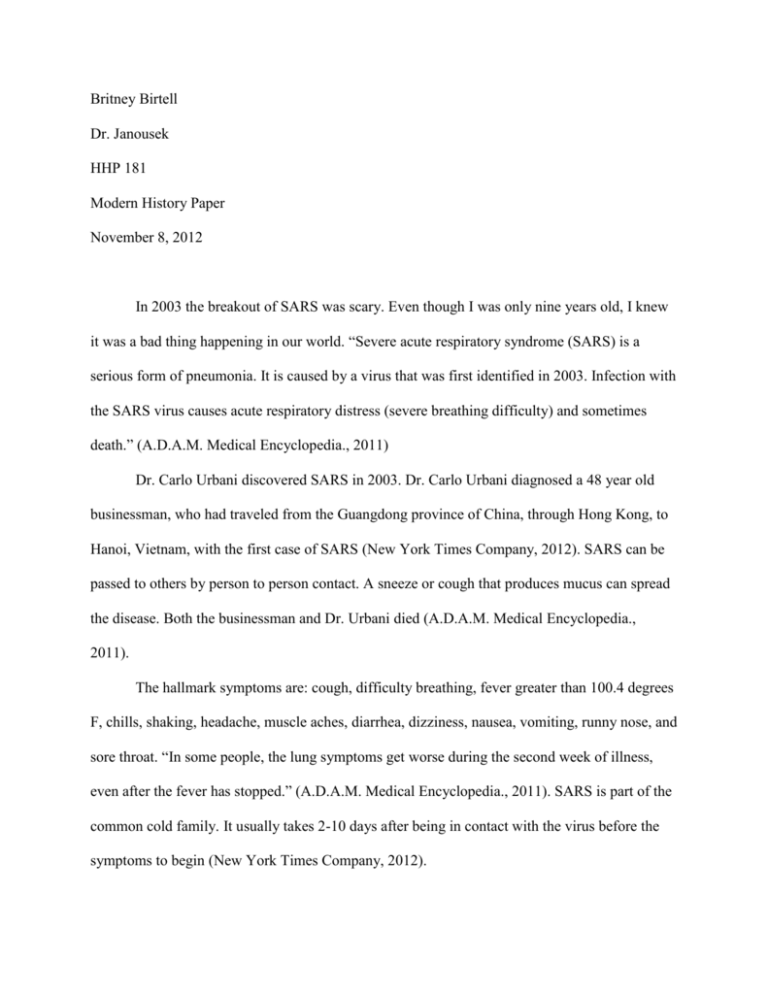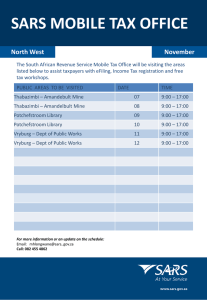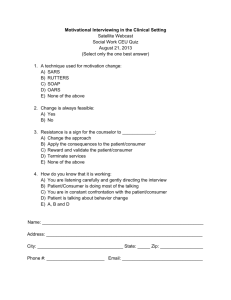References
advertisement

Britney Birtell Dr. Janousek HHP 181 Modern History Paper November 8, 2012 In 2003 the breakout of SARS was scary. Even though I was only nine years old, I knew it was a bad thing happening in our world. “Severe acute respiratory syndrome (SARS) is a serious form of pneumonia. It is caused by a virus that was first identified in 2003. Infection with the SARS virus causes acute respiratory distress (severe breathing difficulty) and sometimes death.” (A.D.A.M. Medical Encyclopedia., 2011) Dr. Carlo Urbani discovered SARS in 2003. Dr. Carlo Urbani diagnosed a 48 year old businessman, who had traveled from the Guangdong province of China, through Hong Kong, to Hanoi, Vietnam, with the first case of SARS (New York Times Company, 2012). SARS can be passed to others by person to person contact. A sneeze or cough that produces mucus can spread the disease. Both the businessman and Dr. Urbani died (A.D.A.M. Medical Encyclopedia., 2011). The hallmark symptoms are: cough, difficulty breathing, fever greater than 100.4 degrees F, chills, shaking, headache, muscle aches, diarrhea, dizziness, nausea, vomiting, runny nose, and sore throat. “In some people, the lung symptoms get worse during the second week of illness, even after the fever has stopped.” (A.D.A.M. Medical Encyclopedia., 2011). SARS is part of the common cold family. It usually takes 2-10 days after being in contact with the virus before the symptoms to begin (New York Times Company, 2012). SARS didn’t just affect the people of the United States. It affected the people of China, Europe, Africa, Russia, Australia, and North and South America. SARS had an impact on the economies. Schools in China had to close due to the outbreak (New York Times Company, 2012). The World Health Organization (WHO) had considered SARS a threat and issued a travel advisory during the outbreak. (A.D.A.M. Medical Encyclopedia., 2011). According to the World Health Organization there were 8096 reported cases throughout the world and 774 deaths caused by SARS (World Health Organization, 2012). The death rate from SARS was 9 to 12% of those diagnosed.” In people over age 65, the death rate was higher than 50%. The illness was milder in younger patients. Many more people became sick enough to need breathing assistance. And even more people had to go to hospital intensive care units.” (A.D.A.M. Medical Encyclopedia., 2011). In the following I am going to state some disturbing facts I read about the virus SARS. The virus can be found in the stool of those carrying the virus where it is known to live up to four days there. If the virus is kept in a freezing temperature it can live up to months or even years (A.D.A.M. Medical Encyclopedia., 2011). “The SARS virus may live on hands, tissues, and other surfaces for up to 6 hours in these droplets and up to 3 hours after the droplets have dried.” (A.D.A.M. Medical Encyclopedia., 2011). Prevention of SARS can be as simple as washing your hands often. Even using hand sanitizer will do the trick if it is inconvenient to wash your hands. Many people during the outbreak wore goggles, gloves, and masks which helped with slowing down the spread of the virus. Covering your mouth or sneezing into your shoulder can help with the spread of the mucus that contains the virus (New York Times Company, 2012). Even though the SARS epidemic has ended it doesn’t mean it can’t happen again expectantly. Our public health has done an excellent job at keeping the epidemic under control and from happening again. References A.D.A.M. Medical Encyclopedia. (2011, Febuary 19). Severe acute respiratory syndrome (SARS). Retrieved from PubMed Health: http://www.ncbi.nlm.nih.gov/pubmedhealth/PMH0004460/ CBC News Online. (2004, April 22). SARS. Retrieved from CBC News: http://www.cbc.ca/news/background/sars/ New York Times Company. (2012). Severe acute respiratory syndrome. New York Times. World Health Organization. (2012). Summary of probable SARS cases with onset of illness from 1 November 2002 to 31 July 2003 . Retrieved from World Health Organization: http://www.who.int/csr/sars/country/table2004_04_21/en/index.html




